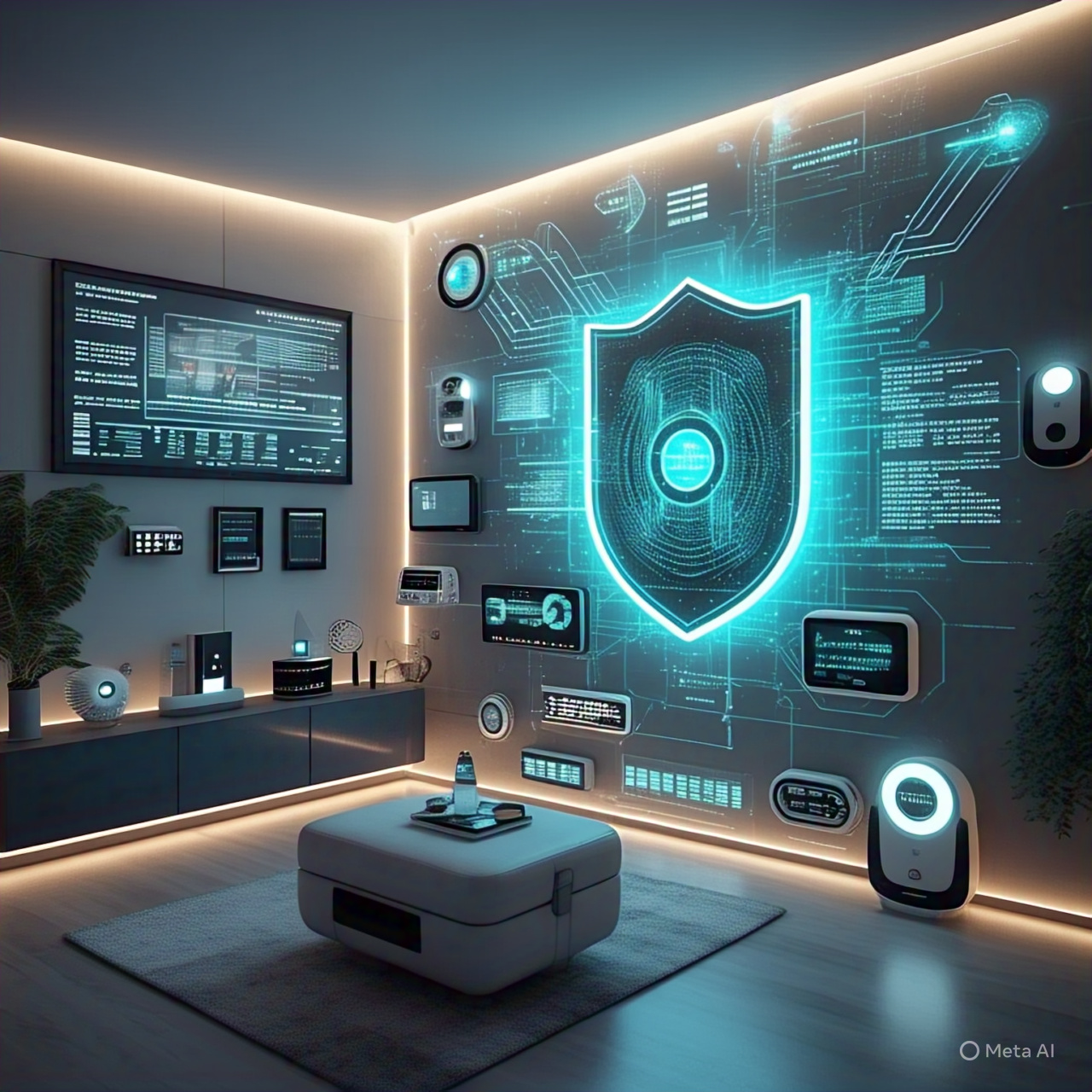We can’t imagine modern life without the Cybersecurity for IoT.
The Internet of Things (IoT) is ubiquitous, found in smart homes as well as in factory automation.
But being connected also means being vulnerable.
Internet of Things cybersecurity is now a must-have, not a luxury.
🌐 What is the Internet of Things?
-
The term “Internet of Things” (IoT) describes a system whereby many physical items are interconnected and able to exchange data with one another.
-
Some examples include industrial machinery, fitness trackers, smart thermostats, connected automobiles, and smart televisions.
-
Right now, these devices are collecting, transmitting, and analyzing data.
-
There are new dangers associated with the Internet of Things (IoT), despite the fact that it promotes convenience, boosts productivity, and refines procedures.
🚨 Cybersecurity for IoT: The Importance of
-
Internet of Things devices often do not have the usual security features due to hardware limitations.
-
They handle sensitive data including login credentials, medical records, and GPS whereabouts.
-
A breach could lead to issues with national security, financial loss, or even identity theft.
-
The default passwords and software on many devices are outdated, making them easy prey.
🔓 The Most Typical Dangers to the Cybersecurity for IoT
-
When hackers have access to Internet of Things (IoT) devices, they may launch massive distributed denial of service (DDoS) attacks using botnets.
-
Interception of data in transit between devices is known as man-in-the-middle (MitM).
-
Hackers use device spoofing to gain access to networks by impersonating legitimate devices.
-
Devices get infected with illegal software, a phenomenon known as firmware hijacking.
-
Ransomware: Locks smart devices until a ransom is paid.
🔐 Key Components of Cybersecurity for IoT
-
Device authentication is a crucial part of internet of things cybersecurity as it verifies the identity of devices trying to connect to the network.
-
Encryption safeguards data while it is being stored or transferred.
-
Protects the system from unauthorized users by implementing access control measures.
-
Prevents the installation of tampered software using firmware integrity checks.
-
Identifies abnormalities and takes timely action via real-time monitoring.
🛡️ Secure Methods for Internet of Things Devices
-
Update the default login details immediately.
-
Make sure to set a robust and unique password for each device.
-
It is critical to implement multi-factor authentication (MFA).
-
Keep firmware and software patches up-to-date.
-
Disable any features and ports that are not being used.
-
Restrict device connectivity to the local area network only.
🌐 Security Protocols for a Network
-
Employ firewalls and intrusion detection systems (IDS).
-
All Internet of Things devices should be placed on separate VLANs.
-
Make advantage of Virtual Private Networks (VPNs) for remote access.
-
In order to detect unusual patterns, monitor the data flow.
-
Implement rate-limiting for API requests and network traffic.
🤖 AI and Machine Learning for Internet of Things Security
-
Using machine learning models, it is feasible to discover behavior anomalies in real-time.
-
It is possible to automate threat detection and response using AI.
-
Behavioral analytics has the potential to uncover new forms of attacks.
-
AI makes human intervention less necessary.
☁️ “Cloud Security for the IoT Platform”
-
The vast majority of Internet of Things devices send data to cloud servers for processing.
-
Data stored and processed in the cloud must be safe.
-
Secure the data transfer between the device and the cloud.
-
Regularly test and audit Internet of Things (IoT) systems hosted in the cloud.
🏠 The Security of the Internet of Things-Related Data in Various Industries
-
Smart Home Technology
-
Smart lights, doorbells, and cameras may all be hacked.
-
Breach detection might lead to house invasion or surveillance.
-
-
Healthcare
-
Pacemakers and insulin pumps are examples of medical equipment that must be safe.
-
The processing of patient data must adhere to HIPAA requirements.
-
-
Manufacturing
-
Industrial Internet of Things (IIoT) allows for the control of robotic arms and sensors.
-
Insecure systems pose a threat to both productivity and public safety.
-
-
Automotive
-
Connected cars use the Internet of Things (IoT) for navigation, updates, and maintenance.
-
It is possible to remotely manipulate vehicle systems by hacking.
-
-
Agriculture
-
Drones and irrigation systems are part of the Internet of Things (IoT) in farming.
-
Securing data and controlling critical equipment requires protection.

-
✅ Benefits of Internet of Things Cybersecurity
-
📏 Data protection: Preserves confidential data.
-
🛠️ Operational continuity: Protects against disruptions in operations caused by cyberattacks.
-
💸 Saves money: Avoids financial losses caused by data breaches and ransom demands.
-
👥 Trust-building: Users will have more confidence in your products and services if you can earn their trust.
-
🧾 Regulatory Compliance: Assists in conforming to requirements such as ISO 27001 and GDPR.
📜 Frameworks and Standards for Cybersecurity
-
The NIST Cybersecurity Framework’s recommended procedures for handling risks.
-
Consumer Internet of Things security standards: ETSI EN 303 645.
-
Information security is governed by ISO/IEC 27001, the global standard.
-
FIPS 140-2: Cryptographic module validation.
-
Standard Assessment Criteria: Information Technology Product Security Evaluation (ISO/IEC 15408).
🔄 Secure Device Lifecycle Management
-
Onboarding: Securely enroll devices with unique identifiers.
-
Upkeep: Monitor performance and install any available software updates.
-
Decommissioning: Make sure to securely wipe data before discarding.
-
Secure the Internet of Things (IoT) at every level to lessen potential dangers.
🚀 Revolutionary Innovations Boosting Internet of Things Security
-
Secure identities and immutable device records are provided by blockchain technology.
-
Because edge computing does data processing locally, it reduces risk.
-
Among the encryption methods that can withstand the test of time is quantum cryptography.
-
Create virtual versions of devices to test updates and remedies for security flaws using digital twins.
🔮 The Future of Cybersecurity for IoT
-
Through 5G networks, a vast array of new Internet of Things devices will be linked.
-
Security has to evolve so it can handle more traffic and more types of devices.
-
A government may mandate a minimum level of security.
-
The use of AI for threat detection is going to explode.
-
Unified security solutions will make protection a breeze.
💼 Tips for Business Owners and Developers
-
Build security into the product from the start rather than after the fact.
-
Maintain a regular schedule of vulnerability scanning and penetration testing.
-
You should choose for solutions that provide audit and compliance features.
-
Make clear choices for customers’ safety and privacy.
-
Educate both staff and customers on best practices for Internet of Things (IoT) security.
⚖️ Factors to Consider from a Legal and Regulatory Perspective
-
Pay attention to laws like the CCPA in California and the GDPR in Europe.
-
Healthcare device security must adhere to FDA and HIPAA rules.
-
The data collected and its intended use should be communicated to users.
-
Data should only be retained for the duration necessary.
-
Make sure individuals have the means to manage or erase their data.
🔑 Choosing the Right Identity and Access Management System
-
Verify that it can handle a growing number of vendors and easily scale.
-
The platform’s functionality for AI and real-time analytics should be confirmed.
-
Platforms with transparent pricing and first-rate customer service should be prioritized.
-
Enforce policies, authenticate users, and encrypt data.
-
Being able to work in both cloud and edge environments is vital.
🏙️ Use in the Actual World
Smart Urban Environments
-
The safety of public transit and surveillance systems is ensured by the Internet of Things.
-
Makes sure that critical infrastructure is safe and always available.
Corporate Settings
-
In office buildings, the Internet of Things is used for lighting, HVAC, and security.
-
Data security helps prevent corporate espionage and sabotage.
-
Smart shelves, inventory sensors, and point-of-sale systems are protected in retail.
-
Secures sensitive information and prevents credit card fraud.
⚠️ Dangers of IoT Cybersecurity Ignorance
-
Monetary losses caused by outages and intrusions.
-
One’s reputation may be damaged and customer trust might be lost.
-
Legal ramifications and regulatory sanctions.
-
More harder to fix problems with a longer time horizon.
-
Unfettered access to private data and devices.
🧠 Last Thoughts
Cybersecurity for the Internet of Things is essential in our highly linked world.
It is important to secure all smart devices, whether they are industrial sensors or home helpers.
Strong Cybersecurity for IoT safeguards allow companies to:
-
Keep following the regulations.
-
Win over your customers’ trust
-
Cease brutal attacks
-
Get ready for the ever-changing risk environment.


